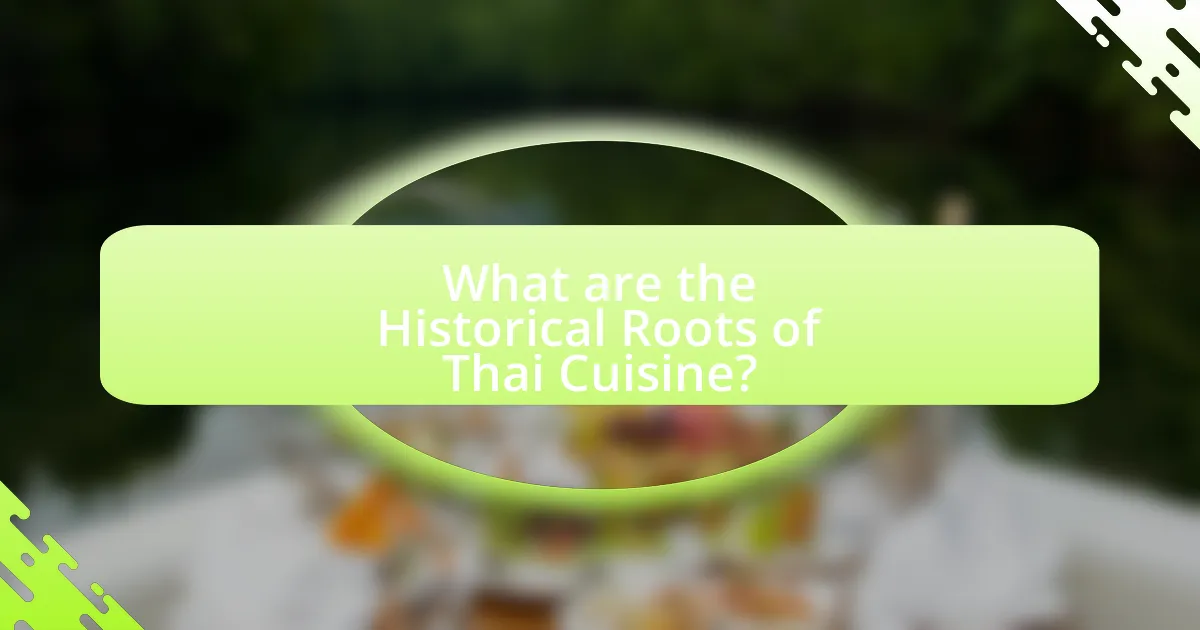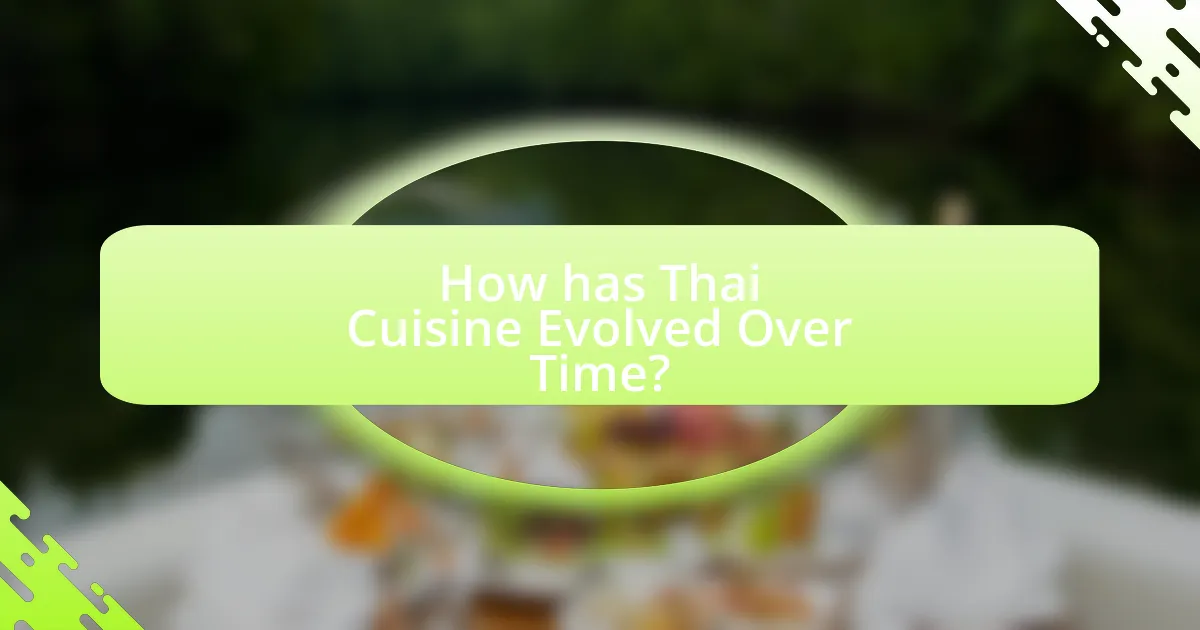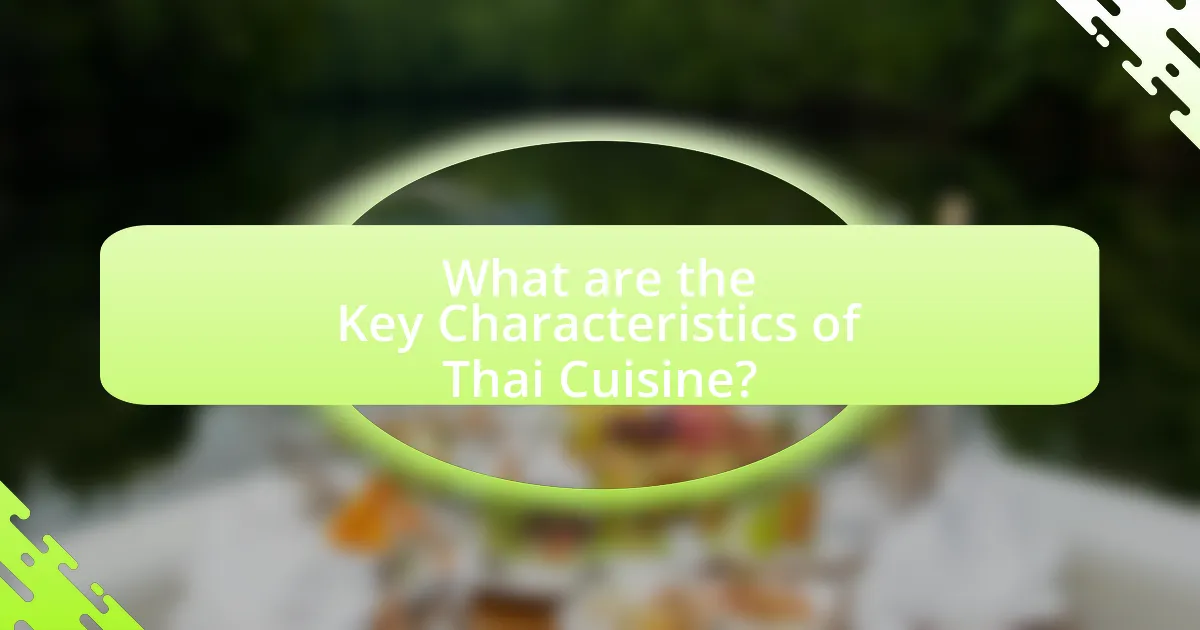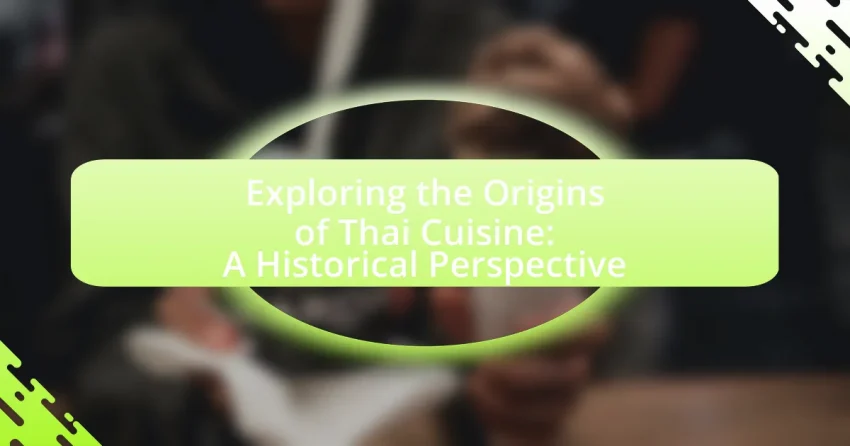The article “Exploring the Origins of Thai Cuisine: A Historical Perspective” delves into the rich historical roots of Thai cuisine, highlighting the influences of various cultures such as Chinese, Indian, and Malay, as well as indigenous practices. It examines how geography and natural resources shaped culinary traditions, the impact of trade routes on ingredient exchange, and the role of Buddhism in promoting vegetarianism. Key historical events, including the establishment of the Ayutthaya and Sukhothai kingdoms, are discussed in relation to their contributions to culinary evolution. The article also explores regional variations within Thai cuisine, essential cooking techniques, and iconic dishes, providing a comprehensive overview of the factors that define and shape Thai food today.

What are the Historical Roots of Thai Cuisine?
The historical roots of Thai cuisine can be traced back to the influences of various cultures, including Chinese, Indian, and Malay, as well as the indigenous practices of the Thai people. The introduction of rice cultivation around 4,000 years ago established rice as a staple food, while the incorporation of spices and herbs from trade routes enriched the flavor profiles. Additionally, the establishment of the Ayutthaya Kingdom in the 14th century facilitated culinary exchanges with foreign traders, further diversifying Thai cuisine. Historical records indicate that the blending of these diverse influences led to the unique balance of sweet, sour, salty, and spicy flavors characteristic of Thai food today.
How did geography influence the development of Thai cuisine?
Geography significantly influenced the development of Thai cuisine by providing diverse ingredients and facilitating trade routes. The country’s location in Southeast Asia, bordered by the Gulf of Thailand and surrounded by mountains, allowed for a variety of agricultural products, including rice, herbs, and spices, which are foundational to Thai dishes. Additionally, Thailand’s proximity to neighboring countries such as China, India, and Malaysia led to the exchange of culinary techniques and flavors, enriching Thai cuisine with influences like curry from India and stir-frying from China. This geographical diversity and cultural exchange have shaped the unique balance of sweet, sour, salty, and spicy flavors that characterize Thai food today.
What role did the natural resources of Thailand play in shaping its culinary traditions?
The natural resources of Thailand significantly influenced its culinary traditions by providing a diverse array of ingredients essential for traditional dishes. The country’s rich agricultural landscape, characterized by fertile plains and a tropical climate, allows for the cultivation of rice, which is a staple in Thai cuisine. Additionally, the abundance of fresh seafood from the Gulf of Thailand and Andaman Sea contributes to the prominence of fish and shellfish in local recipes.
Herbs and spices, such as lemongrass, galangal, and Thai basil, thrive in Thailand’s environment, enhancing the flavor profiles of dishes and reflecting the country’s culinary identity. Furthermore, the availability of fruits like mangoes and coconuts has led to their incorporation in both savory and sweet dishes, showcasing the versatility of Thai cuisine.
Overall, the interplay between Thailand’s natural resources and its culinary practices has created a rich tapestry of flavors and techniques that define Thai food today.
How did trade routes impact the introduction of foreign ingredients and cooking techniques?
Trade routes significantly facilitated the introduction of foreign ingredients and cooking techniques into Thai cuisine. Historical evidence shows that routes such as the Maritime Silk Road and overland pathways connected Thailand with regions like India, China, and the Middle East, allowing for the exchange of spices, herbs, and culinary practices. For instance, the introduction of chili peppers from the Americas via trade in the 16th century transformed Thai cooking, enhancing flavor profiles and leading to the development of iconic dishes. Additionally, techniques such as stir-frying and the use of coconut milk were influenced by Chinese and Indian culinary traditions, respectively, showcasing how trade routes acted as conduits for cultural and gastronomic exchange.
What cultural influences have shaped Thai cuisine over the centuries?
Thai cuisine has been shaped by various cultural influences over the centuries, including Indian, Chinese, and Malay culinary traditions. The introduction of spices and cooking techniques from India, particularly through trade routes, significantly impacted the flavor profiles of Thai dishes. Chinese immigrants brought stir-frying methods and ingredients like soy sauce, which became integral to Thai cooking. Additionally, the influence of Malay cuisine introduced coconut and seafood elements, further diversifying the culinary landscape. Historical interactions, such as trade and migration, facilitated these exchanges, leading to the rich and complex flavors characteristic of modern Thai cuisine.
How did Indian and Chinese culinary practices contribute to Thai food?
Indian and Chinese culinary practices significantly influenced Thai food through the introduction of spices, cooking techniques, and flavor profiles. Indian cuisine contributed spices such as turmeric and coriander, which are essential in Thai curries, while the use of coconut milk in Thai dishes reflects Indian culinary traditions. Chinese culinary practices introduced stir-frying techniques and the use of soy sauce, which have become staples in Thai cooking. The blending of these influences created a unique Thai flavor profile characterized by a balance of sweet, sour, salty, and spicy elements, showcasing the historical interactions between these cultures.
What impact did Buddhism and local beliefs have on Thai cooking styles?
Buddhism and local beliefs significantly influenced Thai cooking styles by promoting vegetarianism and the use of fresh, natural ingredients. The Buddhist principle of non-violence led to a preference for plant-based dishes, especially during religious observances, which shaped the culinary landscape of Thailand. Additionally, local beliefs regarding the balance of flavors and the importance of harmony in meals reflect cultural values, resulting in a diverse array of dishes that emphasize freshness and balance. This integration of spiritual and cultural elements into cooking practices has established a unique Thai cuisine that is both flavorful and reflective of its historical roots.
What are the key historical events that influenced Thai cuisine?
Key historical events that influenced Thai cuisine include the establishment of the Ayutthaya Kingdom in the 14th century, which facilitated trade and cultural exchange with foreign nations, introducing new ingredients and cooking techniques. The influence of Chinese immigrants during the Sukhothai period brought stir-frying methods and noodles, while the arrival of Portuguese traders in the 16th century introduced chili peppers and other spices. Additionally, the modernization efforts during the reign of King Rama V in the late 19th century led to the formalization of Thai culinary practices and the incorporation of Western influences. These events collectively shaped the diverse and rich flavors characteristic of Thai cuisine today.
How did the Ayutthaya and Sukhothai kingdoms contribute to the evolution of Thai food?
The Ayutthaya and Sukhothai kingdoms significantly influenced the evolution of Thai food by introducing diverse culinary practices and ingredients. During the Sukhothai period (1238-1438), rice cultivation flourished, establishing rice as a staple in Thai cuisine. The Ayutthaya kingdom (1351-1767) further expanded culinary diversity through trade with foreign nations, incorporating spices and cooking techniques from China, India, and Persia. This exchange led to the development of complex flavors and dishes, such as curries and stir-fries, which became integral to Thai cuisine. Historical records indicate that the royal courts of Ayutthaya emphasized elaborate feasts, showcasing the importance of food in cultural identity and social status, thereby solidifying the culinary traditions that define modern Thai food.
What role did colonialism play in the transformation of Thai culinary practices?
Colonialism significantly influenced the transformation of Thai culinary practices by introducing new ingredients, cooking techniques, and culinary concepts. During the colonial period, particularly in the 19th and early 20th centuries, Western powers, such as France and Britain, impacted Thai society and culture, including its food. The introduction of Western ingredients like potatoes, tomatoes, and various dairy products altered traditional Thai dishes and expanded the culinary repertoire. Additionally, the colonial emphasis on trade and globalization facilitated the exchange of spices and cooking methods, leading to a fusion of flavors and techniques in Thai cuisine. This period also saw the rise of street food culture and the adaptation of Western dining practices, which further transformed how food was prepared and consumed in Thailand.

How has Thai Cuisine Evolved Over Time?
Thai cuisine has evolved significantly over time, influenced by various cultural, historical, and geographical factors. Initially, Thai food was shaped by the culinary practices of neighboring countries, such as China and India, which introduced ingredients like rice, spices, and herbs. The introduction of chili peppers from the Americas in the 16th century further transformed Thai dishes, enhancing their flavor profiles.
During the Ayutthaya period (1351-1767), royal cuisine developed, emphasizing presentation and complex flavors, which laid the groundwork for modern Thai cooking. The 19th century saw the influence of Western culinary techniques and ingredients, leading to the incorporation of new dishes and cooking methods.
Today, Thai cuisine is characterized by its balance of sweet, sour, salty, and spicy flavors, reflecting its rich history and the fusion of diverse culinary traditions. The global popularity of Thai food has also led to adaptations and variations outside Thailand, showcasing its dynamic nature.
What are the major phases in the evolution of Thai cuisine?
The major phases in the evolution of Thai cuisine include the early influences from neighboring cultures, the establishment of royal cuisine during the Ayutthaya period, and the modernization and globalization of Thai food in contemporary times. Initially, Thai cuisine was shaped by the culinary practices of China, India, and Malaysia, which introduced various spices and cooking techniques. During the Ayutthaya period (1351-1767), royal cuisine became prominent, emphasizing elaborate dishes and presentation, which laid the foundation for modern Thai culinary traditions. In recent decades, globalization has led to the widespread popularity of Thai food worldwide, resulting in adaptations and innovations while maintaining core elements of traditional flavors and ingredients.
How did the introduction of new ingredients during the 19th century change Thai dishes?
The introduction of new ingredients during the 19th century significantly transformed Thai dishes by incorporating flavors and techniques from Western and neighboring cuisines. This period saw the arrival of ingredients such as tomatoes, potatoes, and various spices, which enriched traditional Thai cooking. For example, the use of tomatoes led to the creation of dishes like “Nam Prik” that combined local herbs with these new flavors, enhancing the complexity of Thai cuisine. Additionally, the influence of European cooking methods introduced new preparation techniques, further diversifying the culinary landscape of Thailand.
What culinary innovations emerged in Thailand during the 20th century?
Culinary innovations in Thailand during the 20th century included the introduction of new cooking techniques, the fusion of international flavors, and the popularization of street food culture. The establishment of culinary schools and the influence of Western cuisine led to the adaptation of traditional Thai dishes, incorporating ingredients like cheese and pasta. Additionally, the rise of street food vendors transformed local dining, making diverse Thai dishes accessible to a broader audience. These changes reflect a dynamic evolution of Thai cuisine, driven by globalization and modernization.
How has globalization affected traditional Thai cooking?
Globalization has significantly influenced traditional Thai cooking by introducing diverse ingredients and culinary techniques from around the world. This integration has led to the adaptation of traditional recipes, incorporating elements such as Western dairy products and international spices, which were previously unavailable in Thailand. For instance, the popularity of fusion dishes, like Thai pasta or Thai tacos, exemplifies how traditional flavors are being blended with global cuisines. Additionally, the rise of international food chains and the internet has facilitated the spread of Thai cuisine globally, altering its presentation and preparation methods to cater to a wider audience. This evolution reflects a dynamic interplay between preserving cultural heritage and embracing new culinary trends.
What are the impacts of international tourism on Thai food culture?
International tourism significantly influences Thai food culture by introducing diverse culinary practices and preferences. The influx of tourists leads to the adaptation of traditional Thai dishes to cater to international tastes, resulting in fusion cuisine that blends local ingredients with foreign cooking techniques. For instance, the popularity of Thai street food has surged among tourists, prompting vendors to modify recipes to enhance appeal, such as offering milder flavors or vegetarian options. Additionally, the tourism sector drives the growth of cooking schools and culinary tours, which promote authentic Thai cooking methods while also incorporating global influences. This interaction not only enriches the local food scene but also raises awareness and appreciation for Thai cuisine worldwide, as evidenced by the increasing number of Thai restaurants opening internationally.
How have modern cooking techniques altered traditional Thai recipes?
Modern cooking techniques have significantly altered traditional Thai recipes by introducing methods such as sous-vide, molecular gastronomy, and advanced food processing technologies. These techniques allow for precise temperature control, enhanced flavors, and innovative presentations that were not possible with traditional methods. For instance, sous-vide cooking enables the infusion of flavors into proteins while maintaining moisture, resulting in dishes that retain the essence of traditional Thai flavors but with improved textures. Additionally, molecular gastronomy has led to the creation of unique dishes that reinterpret classic Thai ingredients, such as using foams or gels to present familiar flavors in new forms. This evolution reflects a broader trend in culinary arts where traditional recipes are adapted to incorporate modern techniques, enhancing both the dining experience and the versatility of Thai cuisine.
What are the regional variations within Thai cuisine?
Thai cuisine exhibits significant regional variations, primarily categorized into four main regions: Central, Northern, Northeastern (Isan), and Southern Thailand. Central Thai cuisine, which includes Bangkok, is known for its balance of flavors and use of ingredients like coconut milk and fresh herbs. Northern Thai cuisine features dishes such as Khao Soi, characterized by its use of curry and noodles, and often incorporates less spicy flavors. Northeastern Thai cuisine, or Isan, is recognized for its bold flavors, particularly in dishes like Som Tum (papaya salad) and Larb (spicy meat salad), utilizing ingredients like fish sauce and lime. Southern Thai cuisine is distinguished by its heavy use of coconut and seafood, with dishes such as Massaman curry and various spicy curries. These regional differences reflect local ingredients, cultural influences, and historical trade routes, showcasing the diversity within Thai culinary traditions.
How do the flavors and ingredients differ between Northern and Southern Thai dishes?
Northern and Southern Thai dishes differ significantly in flavors and ingredients, with Northern cuisine emphasizing milder, herbaceous flavors and Southern cuisine showcasing bold, spicy, and coconut-rich profiles. Northern Thai dishes often incorporate ingredients like fresh herbs, garlic, and fermented products, such as fermented soybeans, while Southern Thai cuisine prominently features coconut milk, shrimp paste, and a variety of chilies, resulting in a spicier taste. For example, dishes like Khao Soi from the North are characterized by a creamy curry broth with egg noodles, whereas Southern dishes like Massaman curry are known for their rich, spicy, and aromatic qualities, often enhanced by the use of tamarind and peanuts. This distinction is rooted in the geographical and cultural influences of each region, with the North being influenced by neighboring countries and the South by maritime trade and local agriculture.
What unique culinary practices are found in Isan cuisine?
Isan cuisine features unique culinary practices such as the use of sticky rice as a staple, the incorporation of bold flavors through fermented fish sauce, and the preparation of dishes like som tam (spicy green papaya salad) that highlight fresh, local ingredients. These practices are rooted in the region’s agricultural traditions and cultural influences, particularly from Laos, which emphasize communal eating and the use of herbs and spices to enhance flavor. The reliance on grilling and steaming methods also distinguishes Isan cooking, reflecting the local preference for healthier cooking techniques.

What are the Key Characteristics of Thai Cuisine?
Thai cuisine is characterized by its balance of five fundamental flavors: sweet, sour, salty, bitter, and spicy. This balance is achieved through the use of fresh herbs and spices, such as lemongrass, galangal, and chili, which are integral to the dishes. Additionally, Thai cuisine emphasizes the use of fresh ingredients, often incorporating vegetables, seafood, and meats that are locally sourced. The cooking techniques, including stir-frying, steaming, and grilling, contribute to the vibrant presentation and complex flavors of the food. Historical influences from neighboring countries, such as China and India, have also shaped Thai culinary practices, making it a unique blend of various cultural elements.
What are the fundamental flavors that define Thai food?
The fundamental flavors that define Thai food are sweet, sour, salty, bitter, and spicy. These flavors are achieved through the use of key ingredients such as fish sauce for saltiness, lime juice for sourness, sugar or palm sugar for sweetness, chili for spiciness, and various herbs for bitterness. The balance of these flavors is essential in Thai cuisine, reflecting the cultural emphasis on harmony and complexity in taste. Historical influences, including Chinese, Indian, and Malay cuisines, have shaped these flavor profiles, making Thai food distinct and globally recognized.
How do sweet, sour, salty, and spicy elements interact in Thai dishes?
Sweet, sour, salty, and spicy elements in Thai dishes interact to create a balanced and harmonious flavor profile. Each element complements the others; for instance, sweetness from ingredients like palm sugar can soften the heat of chili peppers, while sourness from lime juice or tamarind can enhance the overall freshness of the dish. Salty components, often derived from fish sauce, provide depth and umami, which rounds out the flavors. This intricate balance is rooted in Thai culinary philosophy, emphasizing the importance of achieving a multi-dimensional taste experience. Historical influences, such as the integration of Chinese, Indian, and Malay cuisines, have shaped these interactions, leading to the distinctive flavor combinations found in Thai cooking today.
What role does freshness play in the preparation of Thai meals?
Freshness is crucial in the preparation of Thai meals as it directly influences flavor, texture, and nutritional value. Thai cuisine emphasizes the use of fresh herbs, vegetables, and proteins, which contribute to the vibrant and aromatic qualities characteristic of the dishes. For instance, ingredients like basil, cilantro, and lime are often used in their freshest form to enhance the overall taste profile. Additionally, the use of fresh seafood and meats ensures that the dishes maintain their intended flavors and textures, aligning with traditional cooking practices that prioritize quality and seasonal availability. This focus on freshness not only elevates the culinary experience but also reflects the cultural significance of using locally sourced ingredients in Thai cooking.
What cooking techniques are essential in Thai cuisine?
Essential cooking techniques in Thai cuisine include stir-frying, steaming, and grilling. Stir-frying, often done in a wok, allows for quick cooking at high heat, preserving the flavors and textures of ingredients. Steaming is commonly used for dishes like dumplings and fish, ensuring moisture retention and enhancing natural flavors. Grilling, particularly over charcoal, imparts a smoky flavor to meats and vegetables, which is a hallmark of Thai street food. These techniques are foundational in creating the balance of flavors and textures that characterize Thai dishes, reflecting the country’s culinary heritage.
How does stir-frying differ from steaming in Thai cooking?
Stir-frying and steaming are two distinct cooking techniques in Thai cuisine. Stir-frying involves cooking ingredients quickly in a small amount of oil over high heat, which enhances flavors and creates a slightly crispy texture, often seen in dishes like Pad Thai. In contrast, steaming uses water vapor to cook food gently, preserving nutrients and resulting in a softer texture, commonly used for dishes like Thai dumplings. The difference lies in the cooking method and the resulting texture and flavor profile of the food.
What are the traditional methods of preparing curry in Thai cuisine?
Traditional methods of preparing curry in Thai cuisine include the use of mortar and pestle for grinding fresh ingredients, such as herbs and spices, to create curry pastes. This technique is essential for developing the flavors and aromas characteristic of Thai curries. Additionally, traditional cooking involves simmering the curry paste with coconut milk and various proteins or vegetables, allowing the ingredients to meld together. Historical practices emphasize the importance of fresh, local ingredients, which are often sourced from markets and gardens, reflecting the regional diversity of Thai cuisine.
What are the most iconic dishes in Thai cuisine?
The most iconic dishes in Thai cuisine include Pad Thai, Tom Yum Goong, Green Curry, Som Tum, and Massaman Curry. Pad Thai is a stir-fried noodle dish that combines rice noodles with shrimp, tofu, peanuts, and bean sprouts, reflecting the influence of Chinese cuisine. Tom Yum Goong is a hot and sour soup featuring shrimp, lemongrass, and kaffir lime leaves, showcasing the balance of flavors central to Thai cooking. Green Curry, made with green chili paste, coconut milk, and various proteins, is known for its rich and spicy profile. Som Tum, a green papaya salad, highlights the use of fresh ingredients and is often served with sticky rice. Massaman Curry, influenced by Persian cuisine, combines meat with potatoes and peanuts in a rich, aromatic sauce. These dishes exemplify the diverse flavors and cultural influences that define Thai cuisine.
What makes Pad Thai a staple in Thai culinary culture?
Pad Thai is a staple in Thai culinary culture due to its historical significance and balanced flavor profile. Originating in the 1930s, it was promoted by the Thai government as a national dish to unify the country and encourage rice noodle consumption. The dish combines rice noodles, shrimp or chicken, tofu, eggs, and a mix of tamarind paste, fish sauce, and sugar, creating a harmonious blend of sweet, salty, and sour flavors. This balance reflects the core principles of Thai cuisine, emphasizing fresh ingredients and complex tastes, making Pad Thai not only a popular street food but also a symbol of Thai identity.
How does Tom Yum reflect the essence of Thai flavors?
Tom Yum reflects the essence of Thai flavors through its bold combination of sour, spicy, salty, and aromatic elements. This iconic soup typically features ingredients like lemongrass, kaffir lime leaves, galangal, fish sauce, and chili, which together create a complex flavor profile that is characteristic of Thai cuisine. The balance of these flavors is rooted in the Thai culinary philosophy of harmony, where contrasting tastes enhance each other, exemplifying the cultural emphasis on freshness and vibrancy in food. Additionally, Tom Yum’s use of fresh herbs and spices showcases Thailand’s agricultural diversity and the importance of local ingredients in traditional cooking.
What are some practical tips for exploring Thai cuisine at home?
To explore Thai cuisine at home, start by sourcing authentic ingredients such as lemongrass, galangal, and Thai basil, which are essential for achieving genuine flavors. Utilizing recipes from reputable Thai cookbooks or online platforms can guide you in preparing traditional dishes like Pad Thai or Tom Yum soup. Engaging in cooking classes, either in-person or virtually, can enhance your skills and understanding of Thai culinary techniques. Additionally, experimenting with regional variations of Thai dishes can provide a broader perspective on the cuisine’s diversity, reflecting its historical influences from neighboring countries.
